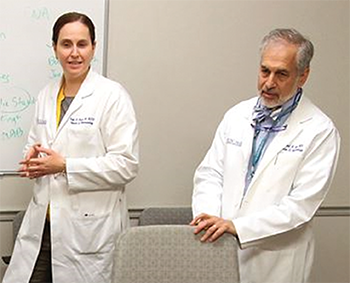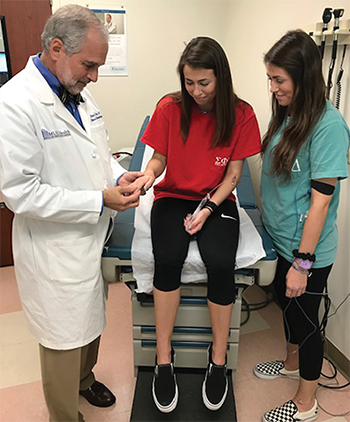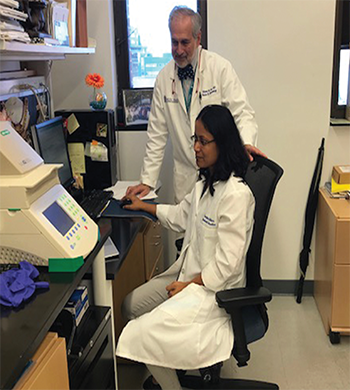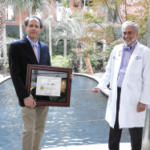
Dr. Silver and Dr. Hant, MUSC Fellowship Program Director, conduct a didactic session for fellows.
The Division of Rheumatology and Immunology at the Medical University of South Carolina (MUSC), Charleston, was formally established in 1974 by its first division chief, E. Carwile LeRoy, MD. Twenty-one years later, when Richard M. Silver, MD, assumed leadership, the division had acquired international renown for its scleroderma research. Now, having just retired as division chief, Dr. Silver says that’s a reputation he is “proud to say still exists.” It’s safe to say, in fact, that the division’s national and international reputation for clinical and research innovation has grown exponentially.
During Dr. Silver’s tenure, there was significant growth in the number of faculty members employed, in its clinical reach, and in research funding and innovation. Dr. Silver accomplished these goals by focusing on the essential prongs of recruiting excellent researchers, growing the research funding base and fostering outreach to diverse patient populations.
Career Path
A professor of medicine and pediatrics, Dr. Silver was named Distinguished University Professor at MUSC in 2007. His own research, focusing on scleroderma, has advanced knowledge of scleroderma lung disease. For example, he and his colleagues were the first to use bronchoalveolar lavage to characterize scleroderma lung disease.
He credits his growth as an expert in academic rheumatology to his exposure to several esteemed mentors: Nortin Hadler, MD, at the University of North Carolina, Chapel Hill, one of his first attendings; the late Barbara Ansell, MD, a pediatric rheumatologist at Taplow and the Northwick Park Hospital in London, with whom he spent nine months learning about juvenile idiopathic arthritis; and the late Nathan Zvaifler, MD, his division chief and mentor during a fellowship at the University of California, San Diego (UCSD), who introduced him to immunology and bench research and who taught him “to probe and question the dogma in our field.”
During Dr. Silver’s tenure, there was significant growth in the number of faculty members employed, in its clinical reach, & in research funding & innovation.
Dr. Silver says the late Dr. LeRoy, who hired Dr. Silver as a faculty member at MUSC in 1981, was another of his mentors. “Dr. LeRoy was one of the giants in the field of scleroderma, and he allowed me to develop my own footprint and expertise in scleroderma and fibrosis research.”
Key Recruitments

Twin sisters Kaylee and Haylee Thomas, now sophomores in college, have been followed by Dr. Silver since age 7.
Early in his leadership, Dr. Silver recognized that MUSC’s location afforded the division an opportunity to study rheumatic disease disparities, especially in scleroderma and lupus. African-Americans—in particular the Gullah, who reside in the low country of the Carolinas and Georgia and are descendants of enslaved Africans whose roots can be traced to Sierra Leone in West Africa—have a high prevalence of connective tissue diseases and disproportionately worse outcomes. Dr. Silver wanted to build a lupus center, so he recruited Gary Gilkeson, MD, an authority in lupus, from Duke University, in 1996. Following Dr. Silver’s initial stint as principal investigator for a Multidisciplinary Clinical Research Center grant from the National Institutes of Health, Dr. Gilkeson became the principal investigator for two subsequent grants, including a current Core Center for Clinical Research P30 grant funded by the National Institute of Arthritis and Musculoskeletal and Skin Diseases.
Dovetailing with an existing endocrinology community outreach program, Dr. Gilkeson increased outreach to the Gullah African-American community. That program now includes clinical environmental genetics to determine sources of the health disparities in that population.
Helping bolster research into the genetic aspects are Paula Ramos, PhD, and a recent recruit, Betty Tsao, PhD, from UCLA, who has assumed one of two newly endowed chairs.
In the interim, Dr. Silver continued to recruit others for the lupus team, including Tammy Nowling, PhD, Diane Kamen, MD, Melissa Cunningham, MD, PhD, and Eric Zollars, MD, PhD.
Another recruitment vital to the success of the division and its scleroderma research is that of Carol Feghali-Bostwick, PhD, who came from the University of Pittsburgh to claim the other endowed chair as co-director with Dr. Silver of the Scleroderma Center.
When Dr. Gilkeson joined the faculty in 1996, he brought along his fellow James Oates, MD, to the division. Dr. Oates recalls, “When I first met Dr. Silver, I knew I was in the right place. It was clear that his philosophy for physician-scientists was the same as mine: You need protected time and support. And that shows in the way he has run the division all along.”
As it turns out, the double recruitment has more than paid off: After a national search, Dr. Oates has now become the division chief.
Other Key Recruits

Dr. Silver reviews data with PhD candidate Tanjina Akter.
Following his interests in pediatric rheumatology, a passion developed by his time with Dr. Ansell prior to his UCSD fellowship, Dr. Silver had long treated children, as well as adults, at MUSC. He also wanted to establish a Division of Pediatric Rheumatology. He had been close to the family of Natasha Ruth, MD, since her teenage years, when he treated her mother for systemic sclerosis.
Indeed, Dr. Ruth says watching Dr. Silver with her mother and being introduced to rheumatologists at MUSC fostered her own interest in rheumatology. After medical school and a pediatric residency, she narrowed her choice to pediatric rheumatology and applied to train at Cincinnati Children’s Hospital Medical Center, where a recommendation letter from Dr. Silver to the late David Glass, MD, secured her fellowship and her future employment at MUSC. (Dr. Silver’s letter included the remark that Dr. Ruth would need her pediatric training since he had a job waiting for her if she were accepted for a fellowship.) Dr. Ruth says she accecpted the challenge of starting a new Division for Pediatric Rheumatology because she knew she would have the full support of Dr. Silver and his colleagues.
She also managed, with Dr. Silver’s help, to recruit her former mentor from Cincinnati, Murray Passo, MD, as well as Robert Warren, MD, PhD, MPH, and Mileka Gilbert, MD, PhD. The pediatric division became South Carolina’s first referral center for childhood rheumatic diseases.
Proudly, Dr. Silver says he has recruited another young physician for that division: his daughter, Kate Silver, MD, who holds a dual appointment in adult and pediatric rheumatology.
Funding Accelerates
The division established the South Carolina Inflammation and Fibrosis Center. This was funded by philanthropic contributions and a matching grant from the South Carolina SmartState Centers for Economic Excellence. (In 2002, the South Carolina General Assembly established the SmartState Program, funding it with proceeds from the South Carolina Education Lottery. The legislation authorizes the state’s three public research institutions—Clemson University, MUSC and the University of South Carolina—to use state lottery funds to create Centers of Economic Excellence in research areas that will advance South Carolina’s economy.) The philanthropic donations came first. When queried about his expertise in securing that funding, Dr. Silver attributes the donations, large and small, to grateful patients and long-lasting relationships.
Then, during application for the SmartState funding, he and his colleagues wrote their protocol noting the two diseases studied at MUSC, scleroderma and lupus, are marked by inflammation and fibrosis. They proposed, said Dr. Silver, that “We would use these two diseases that we have expertise in as prototypes for [researching] other major diseases with even greater morbidity, mortality and societal impacts.” That positioning strategy worked and resulted in the establishment of the center, as well as the endowed chairs for Drs. Tsao and Feghali-Bostwick.
Other Accolades
When asked about other accomplishments during his tenure as division chief, Dr. Silver notes he is proud of the fact that during his tenure and that of Dr. LeRoy, the division graduated more than 85 fellows, several of whom have gone on to become division directors themselves, including the late Joseph Korn, MD (Boston University), Bashar Kaheleh, MD (University of Toledo), and JoAnn Hornsby, MD (West Virginia University).
Dr. Silver is also very proud of the fellows who have gone on to become Fellowship Program Directors: Marcy Bolster, MD (Massachusetts General Hospital), Leslie Staudt, MD (University of Texas, San Antonio), and Faye Hant, DO (MUSC).
Dr. Oates, a former fellow, reflects that one reason he “put his hat in the ring” for the position was its people: “Dr. Silver has built a strong nationally—and in some cases internationally—recognized division and has nurtured a culture of dignity and respect among the faculty.”
Dr. Ruth points out these high-quality researchers “came here because of Rick. He’s an extraordinarily good leader. He’s been around MUSC for so many years that he knows how to navigate [the system] and get things done.”
Gretchen Henkel is a health and medical journalist based in California.



